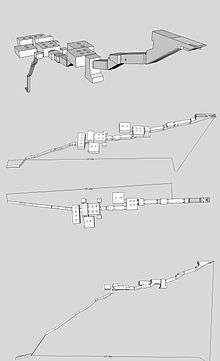KV17
| KV17 | |||
|---|---|---|---|
| Burial site of Seti I | |||
_(Vall%C3%A9e_des_Rois%2C_Th%C3%A8bes_ouest)_-3.jpg) KV17: Seti I's tomb | |||
 KV17 | |||
| Coordinates | 25°44′23.3″N 32°36′06.8″E / 25.739806°N 32.601889°ECoordinates: 25°44′23.3″N 32°36′06.8″E / 25.739806°N 32.601889°E | ||
| Location | East Valley of the Kings | ||
| Discovered | 16 October 1817 | ||
| Excavated by | Giovanni Battista Belzoni | ||
|
| |||
Tomb KV17, located in Egypt's Valley of the Kings and also known by the names "Belzoni's tomb", "the Tomb of Apis", and "the Tomb of Psammis, son of Nechois", is the tomb of Pharaoh Seti I of the Nineteenth Dynasty. It is one of the best decorated tombs in the valley, but now is almost always closed to the public due to damage. As per November 2017 holders of a 1000 EGP entry ticket or of a Luxor Pass can visit this tomb. It was first discovered by Giovanni Battista Belzoni[1] on 16 October 1817. When he first entered the tomb he found the wall paintings in excellent condition with the paint on the walls still looking fresh and some of the artists paints and brushes still on the floor.[2]
The longest tomb in the valley, at 137.19 meters (450.10 feet),[3] it contains very well preserved reliefs in all but two of its eleven chambers and side rooms. One of the back chambers is decorated with the Ritual of the Opening of the Mouth, which stated that the mummy's eating and drinking organs were properly functioning. Believing in the need for these functions in the afterlife, this was a very important ritual. A very long tunnel (corridor K) leads away deep into the mountainside from beneath the location where the sarcophagus stood in the burial chamber. Recently, the excavation of this corridor was completed. It turned out that there was no 'secret burial chamber' or any other kind of chamber at the end. Work on the corridor was just abandoned upon the burial of Seti.
The sarcophagus removed on behalf of the British consul Henry Salt is since 1824 in the Sir John Soane's Museum in London. KV17 was damaged when Jean-François Champollion, translator of the Rosetta Stone, removed a wall panel of 2.26 x 1.05 m (7.41 x 3.44 ft) in a corridor with mirror-image scenes during his 1828-29 expedition. Other elements were removed by his companion Rossellini or the German expedition of 1845. The scenes are now in the collections of the Louvre, the museums of Florence and Berlin.
The tomb became known as the "Apis tomb" because when Giovanni Belzoni found the tomb a mummified bull was found in a side room off the burial hall.
A number of walls in the tomb have collapsed or cracked due to excavations in the late 1950s and early 1960s causing significant changes in the moisture levels in the surrounding rocks. [4][5]

References
- ↑ Dunn, Jimmy. "The Tomb of Seti I". Retrieved March 7, 2014.
- ↑ Romer, John; Romer, Elizabeth (1993). The Rape of Tutankhamun. Michael O'Mara Books Limited. p. 107. ISBN 1-85479-169-9.
- ↑ Bossone, Andrew (April 17, 2008). "Pharaoh Seti I's Tomb Bigger Than Thought". National Geographic News. Retrieved 2008-04-19.
- ↑ Romer, John; Romer, Elizabeth (1993). The Rape of Tutankhamun. Michael O'Mara Books Limited. pp. 25–30. ISBN 1-85479-169-9.
- ↑ Romer, John; Romer, Elizabeth (1993). The Rape of Tutankhamun. Michael O'Mara Books Limited. pp. 49–50. ISBN 1-85479-169-9.
- Reeves, N. & Wilkinson, R. H. The Complete Valley of the Kings, 1996, Thames and Hudson, London.
- Siliotti, A., Guide to the Valley of the Kings and to the Theban Necropolises and Temples 1996, A.A. Gaddis, Cairo.
- Belzoni, Giovanni, Narratives of the operations and recent discoveries in Egypt and Nubia:... 1820
External links
| Wikimedia Commons has media related to KV17. |
- Theban Mapping Project: KV17 - Includes description, images, and plans of the tomb.
- 360° Photosphere virtual visit of Seti I Tomb in the Kings' Valley